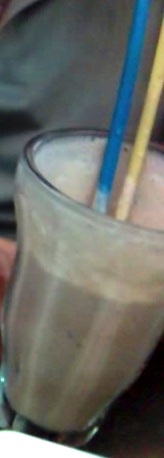Milkshake
2007 Schools Wikipedia Selection. Related subjects: Drink
| Milkshake (American/fast food) Nutritional value per 100 g (3.527 oz) |
||||||||||||||
|---|---|---|---|---|---|---|---|---|---|---|---|---|---|---|
| Energy 140 kcal 580 kJ | ||||||||||||||
|
||||||||||||||
| 100 g corresponds to 95 ml. Percentages are relative to US recommendations for adults. Source: USDA Nutrient database |
||||||||||||||
A milkshake is:
- in the United Kingdom and the New England region of the United States, a beverage which is made from milk and flavourings.
- in Canada and most regions of the United States, a beverage which is made from milk, ice cream, and other flavourings such as fruit and chocolate sauce. This usage is also common in the United Kingdom, alongside the above.
A milkshake made with ice cream, as in North America, is also known as: a thick milkshake in the United Kingdom, a frappe (pronounced "frap") in parts of New England and Canada, and a cabinet in Rhode Island .
Throughout the United States, especially in fast food and casual dining restaurants, a milkshake may be referred to simply as a shake. When an ice cream milkshake is made with malted milk, it is generally called a "malt" or a "malted."
A milkshake is usually prepared in some sort of blender rather than being simply stirred. There are machines which are specifically designed for the blending of milk shakes. Often, these machines mix ingredients and insert air into the milkshake mix, causing the consistency to become smooth and the shake to thicken up as it is blended. Some outlets use machines where milk and mix are frozen and mixed together inside a container within the machine, while others prepare and mix the shake "by hand" within a special stainless steel cup, often called a malt cup or mixing can.
The most common flavours of milkshake are vanilla, chocolate, and strawberry, though other ingredients such as bananas or Oreos may be used. In Rhode Island and Southeastern Massachusetts (Fall River and New Bedford areas) coffee syrup is used as a flavouring with coffee flavoured ice cream to make the local "coffee frappe" or "coffee cabinet" favorite. A common additive is malted milk, which makes a malted milkshake. Fast food restaurants and soda fountains often sell milkshakes. Some milkshake recipes call for ice cream in the flavour of the milkshake, while others call for vanilla ice cream plus a flavour additive, such as a syrup or fruit. These different methodologies often result in a surprisingly large difference in taste, and many people have a distinct preference for one method over the other. Recipes which rely heavily on fresh fruit and are made without ice cream are called smoothies.
Milkshakes can be made from ordinary milk mixed with powder or concentrate although these drinks would simply be considered " flavoured milks" in most places. Common brands include Nesquik, Crusha and Dinkum for the mobile vendor market in the UK. Bottled milkshake is also common, commonly being sold in 330ml, 500ml or 1 litre bottles. Milk Chug, Gulp!, FRijj, Yazoo, Big M, and Mars are well known brands of bottled milkshake.
Milkshakes are particularly popular in Latin America, where they are called batido.
History

A printed reference, from 1885, to a "milkshake" containing some whisky is the first known use of the term . The malted milkshake includes a malted milk powder (containing dried milk, malted barley and wheat flour) which was invented in 1897 by William Horlick, but added to milkshakes for the first time by Ivar Coulson in 1922. The drink was designed as a restorative for invalids and children. Original versions of the drinks were more of an egg nog version than modern versions. Milkshakes began to take their modern form after the invention of the electric blender or drink mixer by Steven Poplawski in 1922 ].
